Al otro lado de la puerta de la Pescadería se encuentra la iglesia parroquial de Santa María de A Régoa, que se ubica en lo que fue convento dominico de San Jacinto, del siglo XVII. Al ser abandonado éste por la orden, tras la Desamortización de los años veinte del siglo XIX, la iglesia conventual pasó a desempeñar las funciones de la desaparecida iglesia parroquial de Santa María de A Régoa, demolida en esta misma centuria, mientras que las dependencias del convento ya en el siglo XX, pasaron a ser utilizadas por el Pío Instituto de las Hijas de la Divina Pastora, dedicadas a la enseñanza hasta hoy. Junto a la Iglesia, partiendo de la pequeña placita que forma el altozano, surge la calle Abelardo Baanante, durante mucho tiempo identificada por la rúa principal de la judería; también llamada de la Calexa y calle Nova (otra nomenclatura habitual, junto a la de la Cruz, en la sustitución de referencias judías), comunica directamente con la Ponte Vella, y en su parte alta muestra un interesante conjunto de casas de construcción popular que se levantaron sobre otras anteriores, que acogían a las familias hebreas, como la de Isaac Chamizo, en el año 1462.
Rather than a Jewish quarter, according to the latest contributions by the local researcher Felipe Aira Pardo, in Monforte de Lemos we should talk about areas of Jewish influence as the medieval town of Cabe did not have an area solely inhabited by Jews, but rather streets and squares where Jewish and Christian families both resided. Even so, the old population inside the walls where the majority of Jews lived in the Middle Ages constitutes per se a space full of mystery where references to a small community abound whose memory has remained indelible thanks to documents, legends and architectonic elements such as the trabuleiros, which form part of the same commercial essence of this place, the capital of the district of Lemos and Ribeira Sacra.
Passing through the various milestones related with the Jews and converts of Monforte also means discovering step by step a large part of the history of this population, refounded in 1104 at the same place as the oestrymniosy, the saefes, the forefathers of the Celtic lemavos, already cited by Plinio, had possibly been settled. According to a lost document from which previous quotes have been kept, on April 10th 1104 count Fruela Díaz and his wife, Countess Estefanía Sánchez, had a new settlement set up at the foot of the Dactonio hill-fort on land donated by the abbey of the monastery of St. Vincent, also giving permission to hold fairs and markets to supply the population. Until the 16th century the high city was the preferred place where the different cultures could be found which went to make up the common history of Monforte, but as from that date – coinciding with the stability of the new state created by the Catholic Monarchs – the majority of the population gradually began to progressively settle along the plain along which the river Cabe runs which has meant that time has stood still in the higher part of the city.
The first documentary evidence of the Jewish presence in the area of the future Monforte de Lemos is a document from 915 in which a certain Ismael is mentioned, a Jew who resided in the city. Before this date the first mentioned of the Jews of Galicia is in the 4th century at which time they are linked with commercial activity. During the Swabian domination, the religious tolerance of this people promoted their presence, facilitating the cohabitation between the different confessions to such an extent that there were marriages between Jews and Christians and made possible a relationship between both. In the early 7th century with the reign of Sisebut, and complying with the stipulations of the III Council of Toledo, an expulsion edict was issued for all Jews in the Visigoth kingdom who had not been christened. Many Jews took flight and sought protection and land in the neighbouring settlement of the Franks and others remained in the peninsula, being christened and thereby giving in to the pressures of the Visigoths. Once Sisebut had died, the Jews who had been christened went back to Judaism which led to an age of social frictions and persecutions. This is why early in 637 compliance with the canons of the council were enforced and there was a mandatory stipulation to the effect that:
The persecutions brought the boom and prosperity of Monforte to a standstill, but the expulsion did not greatly alter the demography of the Jewish community of Galicia in view of the scarce number of Jews residing in Galicia. Neither did the Moslems change much after the invasion which did not prove very effective and only survived for a few years. The Jews kept on pursuing commercial activity and practising medicine in monasteries, hospitals and hostels along the Way of St. James. The Almohad intolerance meant that Galicia became a destination of choice for the Jews in the south who here found a land which was segregated from the power centres and had no conflicts. In this regard, the Jewish quarters of Galicia, as in the case of Extremadura, were luckier than the Castilian-Aragonese Jewish quarters and the obstacles which periodically obstructed cohabitation did not appear in Monforte.
During the course of the 14th century different Lords of Lemos put members of the Jewish community in posts of confidence and important positions. This friendship and support was best exemplified by Prince don Felipe, the uncle of Alfonso XI, who advised the King to take as the royal tax collector his Jewish friend Yuçaf de Écija. In 1334 Pedro Fernández de Castro, Lord of the Monforte manor and the standard bearer of the King - who, in turn, was the chief in Leon, Asturias and Galicia – appointed as the tax collector the Jew don Guillermo (sic) and his brother as the tax collector, don Samuel. Fernando, the Lord and Count of Monforte and the son of Pedro Fernández de Castro, followed a pro-Jewish policy in the mid-14th century, following his father´s footsteps, and in line with the Royal policies promoted by Pedro I the Cruel.
After the slaughters of 1391 in Castile and Aragón, Monforte had to increase its population with Jews fleeing from other Jewish quarters in the Peninsula who were seeking refuge. Contrary to what happened in the rest of the peninsula, the Galicians in the 14th century, lorded over by the local nobility, did not see the Jews as enemies as they were involved in anti-noble social movements which were finally resolved in the «revueltas irmandiñas» peasant revolts of 1467-1469.
Although the Jews had their own district where they situated their synagogue, Mikveh and the rest of their communal facilities with the blessing of the Council, they were mixed with the Christians in various medieval streets in Monforte, particularly around the gates of the town and marketplaces. For instance, we know that in 1449 a certain Moses, a Jew lived in Zapatería Street and that in 1453 Esther, the Jewess lived in the same street as Moses, the Jew, today known as Travesa do Cárcere Vello. In 1474 the family formed by Manuel and his wife Lídica, the Jews lived in Herreros street which today forms part of Praza de España (Spain square). This square was the site until the 19th century of the Romanesque church of Our Lady of Regoa and Jewish families used to live in the vicinity of the churches, taking advantage of the commercial activity they generated. In 1462 Isaac Chamizo lived at Rúa Nova, today Abelardo Baanante, popularly called A Calesa. In 1488 Boaventura Judía had his house at Azouge square, in other words, Market square, today known as Pescaderías Square, right alongside the so-called Puerta de la Alcazaba (Citadel Gate). After the expulsion the house of Boaventura Judía in 1492 came into the possession of the 2nd Count of Lemos, D. Rodrigo Enríquez de Castro.
The Jews tended to live on the mountain slope towards the castle and the monastery of San Vicente del Pino in a classic relationship which occurred in the Middle Ages between Jew, Lords of the Manor and abbot´s residences. The original Jewish quarter may have been located, as tradition would have it, at la Calesa, today Abelardo Baanante Street in the former suburb alongside the Town Hall, from where there is an ascent to the high part or walled monumental area of the city.
In 1462 there is mention of the Jewish family of Chamizo, one of whose members, Isaac, bought a house from Ruy López, something which gave rise a lawsuit against the Christian for having sold a property to a man of a different faith from our own, in other words, someone who was not a Christian. At a much later time, well into the 15th century, there are numerous documents bearing testimony to the Jewish presence in Monforte as they make reference to the payment that the Galician aljamas make to the Crown of Castile and whose amount allows us to deduce their demography and importance and on the eve of the expulsion the aljamas of Monforte, Allariz and Ribadavia are already prominent. The tax distribution in the second half of the 15th century positioned the city as the nucleus of one of the three most important and richest Jewish quarters of Orense. This wealth derived from the silk and cloth trade, silversmithery and the practice of law and medicine.
After the expulsion of 1492 the majority of the Jews who did not wish to convert to Christianity were exiled in Portugal until 1496 when the edict of expulsion from this country was issued. This forced many Jews to go back to neighbouring Galicia, now converting to Christianity but the majority under false pretences. This was to be the start of a long period stretching from the 16th century to the 18th when the Inquisition launched an attack on many Jewish convert or New Christian families settled in Galicia, brought to trial for remaining faithful to the principles of the «Mosaic religion». Although Juan de Gaibor, the secretary of the 2nd Count of Lemos converted to Christianity to avoid expulsion in 1492, some of his family members were to be persecuted according to a document of the Santiago Inquisition in 1580 and some of them were put to death.
A Calexa. Abelardo Baanante Street
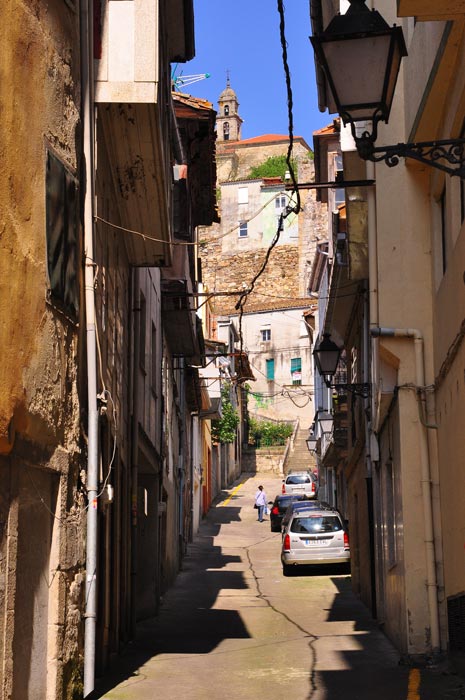
A Régoa Church
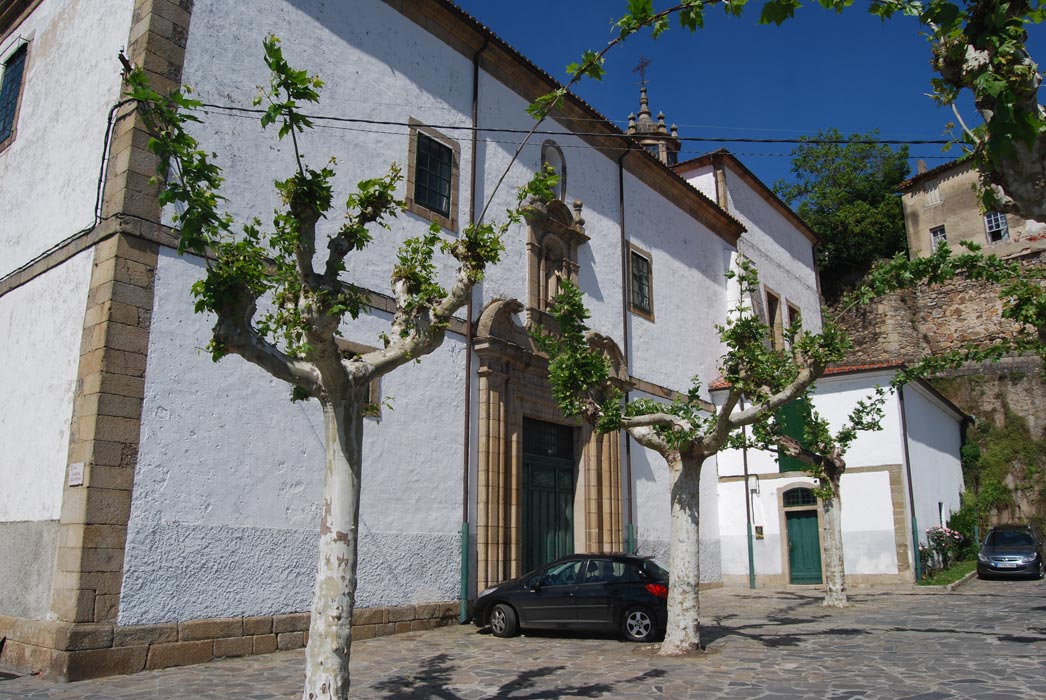
The A Régoa church was founded by the 7th Counts of Lemos in the 17th century. The original name of St. Hyacinth can be put down to the religious order to which it was dedicated and which was regarded as a minor convent.
At present, the church is known by the name of St. Dominic´s as it was connected with the convent of dominicans founded in the 17th century, also has the name of the church A Régoa.
Cardinal Street
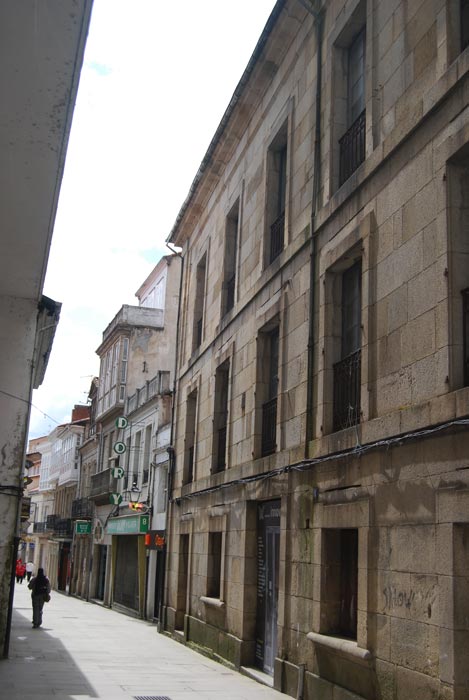
calle de los Sederos (silk dealers´ street), popularly known today as calle del Cardenal was occupied in the Middle Ages by businesses which made and traded cloths and silks.
Silk manufacture was introduced into Spain through the Moslems. Under the Catholic Monarchs at the end of the 15th century official silk weavers were ordered to be subject to exam to demonstrate their knowledge of the trade, thereby achieving a more refined manufacturing technique. As regards the silk shops set up in Galicia, the epicentre was located around the land of Valle de Lemos, Castro Caldelas, Quiroga and Valdedoras.
In Monforte, silk manufacture is established in around the 14th-15th centuries by the Benedictines and in the 16th century by the Franciscans or by the Lords themselves and then the Counts of Lemos.
Hence, in a letter sent by the Count of Lemos from Madrid to Pedro de Valcárcel, his book-keeper in Monforte, on January 4th 1618 he mentions am ambitious project intended to promote and drive on, in this land, silk tactile manufacture. His missive reads:
The count informs him that he is particularly committed to the success of the venture and that, with this in mind, he is very interested that it should go ahead.
Church of St. Vincent and Benedictine Monastery
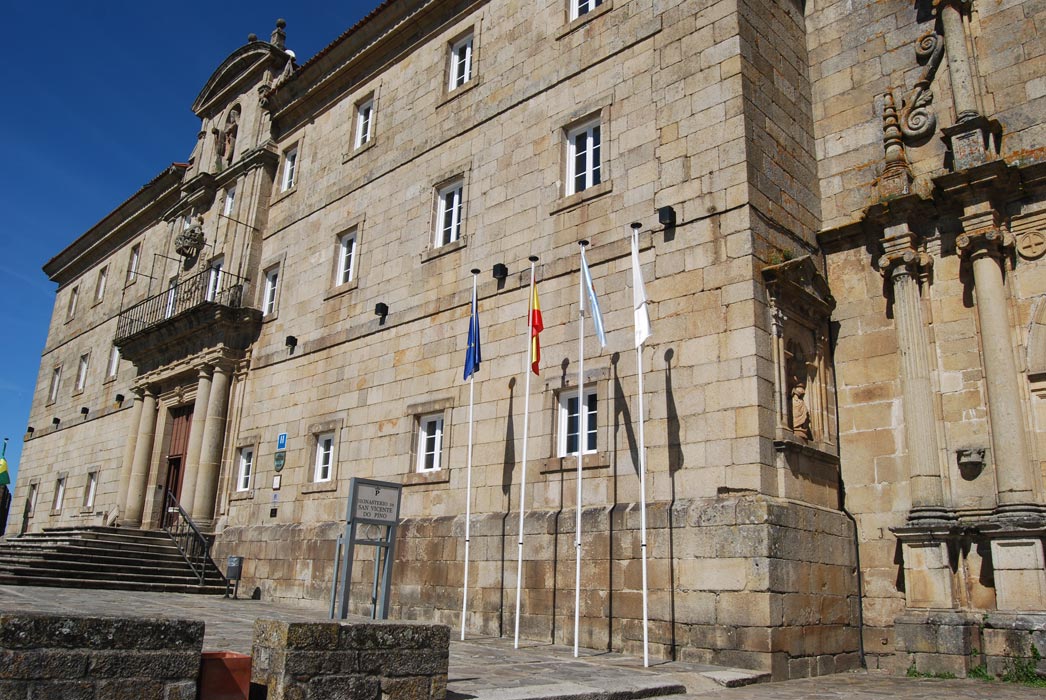
The Benedictine monastery, erected in the 16th century on a previous monastery from the 10th century, constitutes a formidable architectonic display in which the church of St. Vincent of the Pine stands out. This impressive monastic church has a Renaissance gateway, whilst the interior is set in transition Gothic endowed with intricately ribbed vaults. A Baroque organ, silent for some decades now, can be found in a lateral of the chancel. On the main altar there is an interesting allegorical painting portraying the torture of St. Vincent.
A large part of the monastic building currently houses the Monforte de Lemos Tourist Hotel.
Cobblers´ Gate
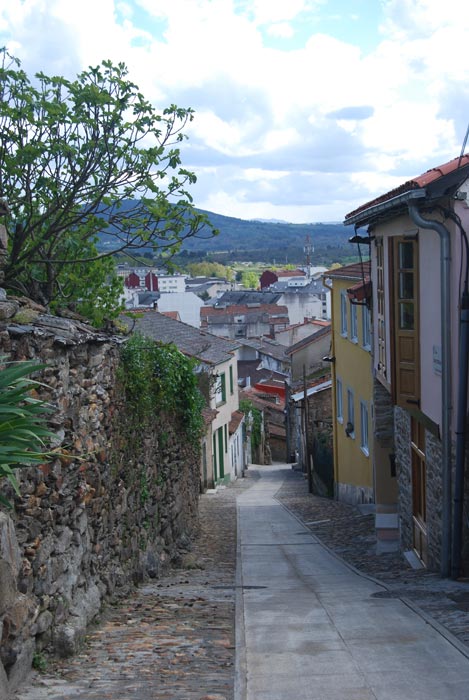
Pescaderías street runs past the wall-walks of the wall and later it connects with Zapatería street where in the 15th century Jewish families like that of Moses the Jew and Esther the Jew lived. Zapatería Street was known from the second half of the 19th century until a few years ago as Cárcere Vella street (old prison), referring to the prison of the judicial district of Monforte which was located here as from the second half of the 19th century until the second decade of the 20th century; later, the prison outbuildings were reconverted into the offices of the Designation of Origin of Ribera Sacra. In the same tower building the start of an arch can be seen, belonging to the original Zapatería gate which is mentioned in documents from the 13th to the 14th centuries. The oldest references of the presence of Jews in the Monforte town may date back to the 10th century when in a document from 915 a certain «Jewish Ismael» is mentioned, a probable reference to a Hebrew, though it was in the 15th century that this collective has its greatest proportion of society as a whole. The popular dislike meant that at a certain time all the residents of Monforte were classed as long-tailed, by extension of the members of their aljama or that even today a memory is conserved of that which, particularly the residents of the neighbouring population of Sarria used to sing to those from Monforte:
Although the majority of Jews in Monforte were craftsmen and traders, particularly highlighting all the silk and cloth merchants, others held important posts in the administration of the Lords´ houses, so the Counts of the Lemos, such as don Samuel, the tax collector and his brother don Guillermo, a tax collector, both in the service of don Pedro Fernández de Castro, the Warlike, a Lord of Monforte in 1334. 15th century documents reveal the major contribution made by the Monforte aljama to the taxes of the Crown of Castile.
Company of Jesus College
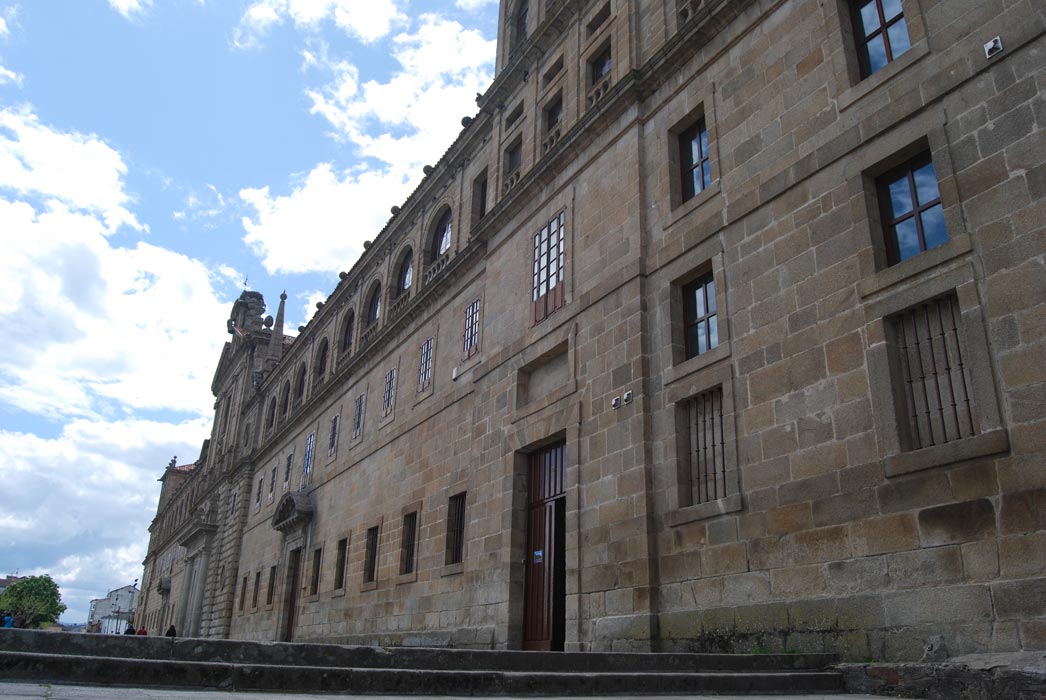
To reach the colegio de la Compañía or de Nosa Señora da Antiga, it is worth extending our route a little to pass by the Convent of the Order of St. Clare which houses the Sacred Art Museum, one of the best of its type in Spain and continue until the Ponte Nova (New Bridge) along Méndez Casal and Ourense streets; then, crossing the river again, take Galicia avenue and Cardenal Rodrigo de Castro street. It was precisely this cardinal who was drove on the work of what is known as Escorial de Galicia, an impressive, Herrera style construction who donated it to the Company of Jesus to be used by young people, as a temple and school consecrated to the Virgin Mary.
Two new Jewish milestones terminate the route here. The first, the splendid scene of the Circumcision of the Baby Jesus, which forms part of the large main retable made of walnut and carried out by Francisco de Moure in the 17th century. The second, again the trabuleiros who form part of the little houses accommodating the Tourism and Information Office.
Falagueria Street

Falagueira street, whose name was changed after the expulsion of the Jews to Cruz (cross) street, joins the Nova and Pescadería gates and constitutes the main thoroughfare of the Jewish district and the medieval city. After a short stretch with rehabilitated houses, the asphalt track becomes a dirt track: on the left, the vegetable gardens have gradual taken up the space of the houses between the Street and the wall, some of whose towers are still standing; on the right, alongside some water mines via which the dampness of the mountain seeps out, the remains of a building still allow us to locate the trabuleiro which is still standing of the former cobblers´ workshop: a spacious windowsill used as a counter so they can do business from inside the house.
On the dirt track the age-old town suddenly becomes a country path amongst market garden mud walls, some of them connected, so tradition would have it, with places where the Crypto-Jews from Monforte were christened in secret. On the left, half way along the path, the slope emerges linking the city with the postigo de los Chaos (Chaos wicket gate), a short cut connecting the district of Os Chaos which is located outside the walls and has been very active for centuries with the upper part.
Further on, also on eth left, a couple of houses serves as the reference for the siting of the old Concello de la Villa (Town Council); for centuries the Town Hall was situated at a large house annexed to the largest of the two aforementioned houses until the municipal administration was transferred in the early 20th century to the outbuildings of the Sancti Spiritu hospital, in the current Comercio street. The larger property was also used on occasion when the town hall was too small for acts related with the very active municipal life of Monforte, something which is borne out by the very name of the street where the town hall was located: Falagueira, which means taking street in Galciain, in other words, the hubbub or chattering. Quite unlike today as its silence is deafening.
Ferreriros street, España Square
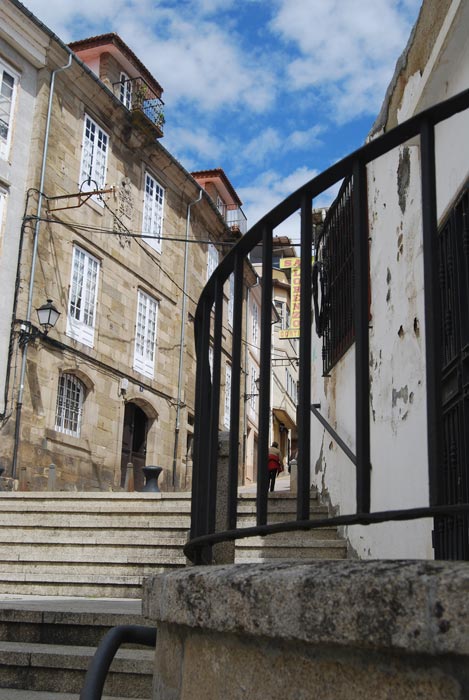
From the place where the Zapatería gate was located to the neighbouring España square, only there are some passages. The high part of this strange square organised in line with a series of staircases which level the uneven ground was resided in the Middle Ages by Jewish craftsmen such as the family formed by Manuel and his daughter Lidica, the Jews. An expansion and meeting place, particularly in summer, with the street vendors who occupy the different levels of the square, this is also the site of the House of Culture, the Library and the Sargadelos Gallery. Very near the square in Doutor Teijeiro street a very popular character in Monforte lived until quite recently, known as O Xudio (The Jew) who ran his small business through one of these trabuleiros which are distributed throughout different points of the city.
Fishmonger´s Gate
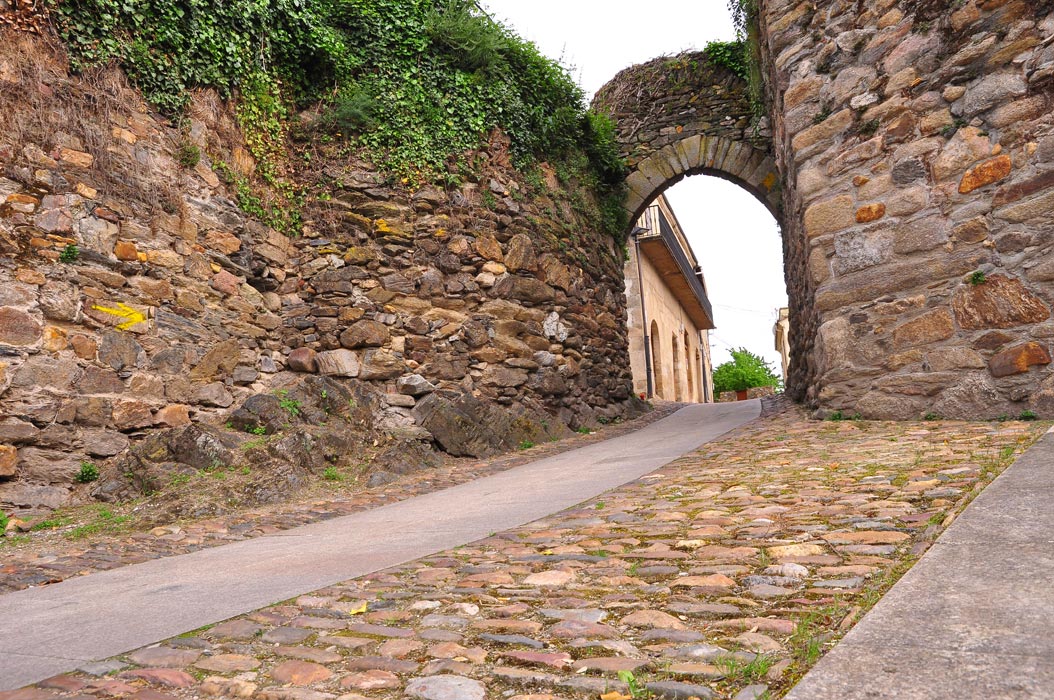
Alson called Alcazaba (citadel) gate, the Fishmonger´s gate connected the old city with the River Cabe and it is one of the accesses which was most important in centuries gone by in the daily life of Monforte. The Pescadería square, alongside which it is located, was traditionally called plaza del Azougue (Quicksilver square) in reference to the azogue or street market that existed here for a long time. According to a document from 1488, the Jewish family of Boaventura Judía lived at this square at a house which in 1492 came into the possession of the Count of Lemos.
Former synagogue

Opposite two houses and only identifiable by the ashlar of the jambs and the well-cut stones of the lintel on the main door, there lies a plot – today privately owned – where several documents mention the Torah of the Jews, undoubtedly the synagogue. Part of the walls is still conserved and the two cellars which were integrated into the whole, one of which has been connected with the Mikveh or ritual bath of the Jews, though the site is currently greatly degraded owing to the passage of time. Slightly further on a new building is situated at the angle separating the street from rúaVella (old street), today wholly abandoned and which, as its name suggests, is one of the oldest in the city; in actual fact, it already bore this name in the 12th century. Until the 16th century, when the new Count´s palace was built on part of the land belonging to the Benedictines – the cause of a long dispute between the 3rd countess of Lemos and the monastery – this road was teeming with life and was populated until the 18th century. It is mentioned in documents from the 17th and 18th centuries as a virtually uninhabited street.
The synagogue
The synagogue (place of congregation, in Greek) is a Jewish temple. It faces Jerusalem, the Holy City, and it is a place for religious ceremonies, communal prayer, studying and meeting.
The Torahis read at the ceremonies. This task is conducted by the Rabbis aided by the cohen or singing child. The synagogue is not only a house of prayer but also an instruction centre as it is there where the Talmudic schools are usually run.
Men and women sit in separate sections.
The synagogue interior contains:
- The Hejal closet located in the east wall, facing Jerusalem, stored inside the Sefer Torah, the scrolls of the Torah, the Jewish sacred law.
- The Ner Tamid, the everlasting flame always lit before the Ark.
- The menorah, a seven-armed candelabrum, a habitual symbol in worship.
- The Bimah, place from where the Torah is read.
Funeral headstone of the Gaibor
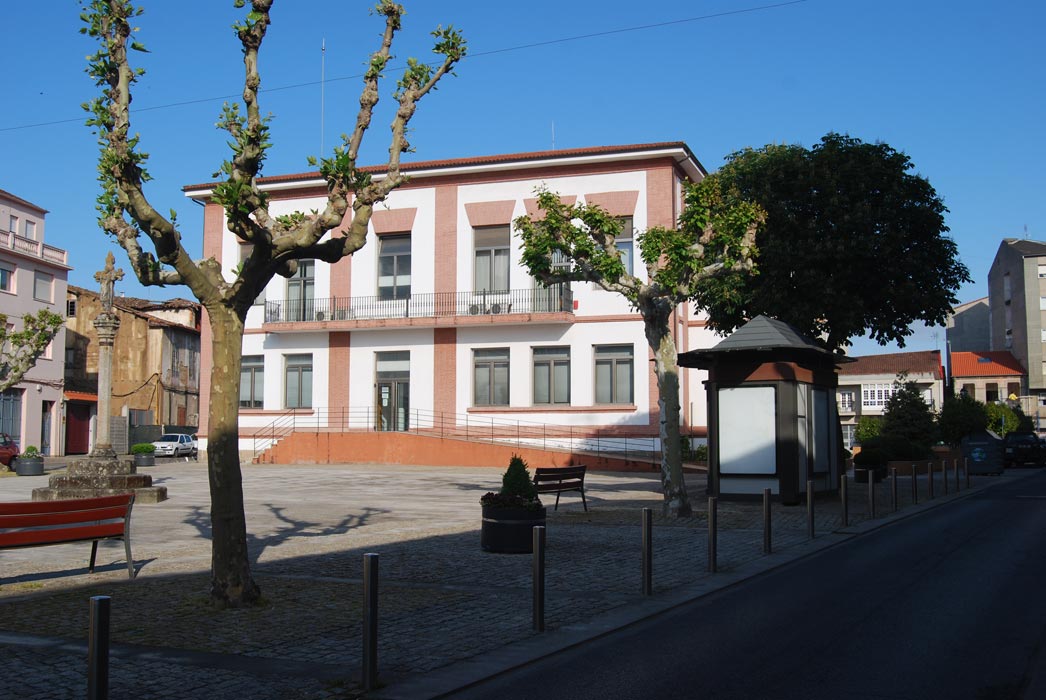
The death of Jorge de Gaibor is related with a popular convert story known as the case of the Christ of the Lashes, perfectly documented by the Santiago Inquisition in 1580. The testimony of one of its servants combined with the fact that he saw his son Juan with a crucifix and some lashes, served as the basis for the accusation that the recent convert was spending his nights whipping an image of Christ on the Cross. Convened by the Holy Court, based in Valladolid at that time, during the journey he felt very sick and had to return quickly to his house in Monforte where he died in a matter of days.
At the Provincial Archaeological Museum of Ourense there is a valuable headstone from Monforte which corresponds to the chapel that the Gaibor founded at the start of the 16th century at the Franciscan convent of St. Anthony of Padua where the Counts of Lemos had their Family pantheon and which indicates that underneath lie Juan de Gaibor and Jorge de Gaibor, residents and councillors of this town.
A piece was missing from the inscription which brought about the erroneous belief, which has now been clarified, that said piece proved the foundation of a house in Monforte de Lemos by the Gaibor lineage.
El Cristo de los Azotes (Christ of the Lashes) and Cristo de la Colada (Christ of the Washing)
One of the best known cases of insults and contempt in the history of Monforte is El Cristo de los Azotes and Cristo de la Colada whose existence is documented until the Napoleonic invasion of the city. Friar Jacobo de Castro, a chronicler of the Franciscan Order, at the time of his visit to the Monforte convent of San Antonio in the 18th century, recorded that some curious pieces were kept there. He says:
Homage Tower
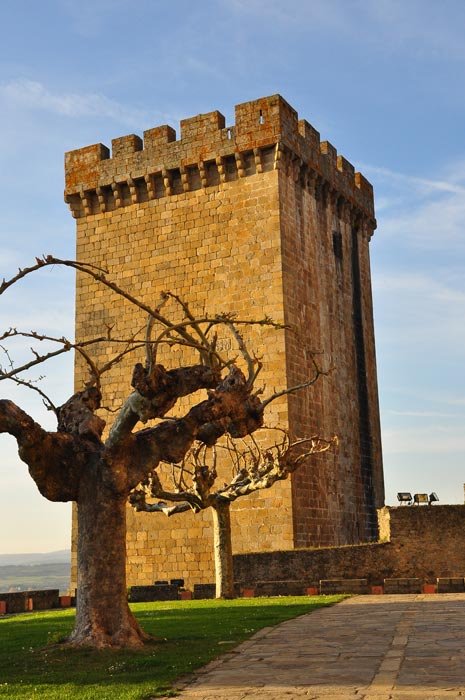
The majestic Homage tower, the main element of the medieval castle crowned by the St. Vincent mountain for over seven hundred years, is one of the symbols most identified with the people of Monforte and the monte fuerte (strong mountain) which lends it name to the city. From the top of this magnificent bastion from the 13th to the 14th centuries you can see the true dimensions of Monforte and its environment, but also establish an interesting starting point in the world of the converted Jews, seeking to resolve the enigma of the meaning of the stars of Solomon (the five tips representing the five books of the Pentateuch, a symbol also known for centuries in Galicia as the Goblin cross) which are located amongst the headstone signs and stonemason marks of their ashlar.
These stonemason marks are located in the oldest part of the Homage Tower from the 14th century. On the east face, we can see headstone signs and stonemasons´ marks. These marks were the assurance of quality of the work and they identified the engraver or school of engravers who have worked on the ashlar. The most common is the star of five tips or the Seal of Solomon.
Houses of the Gaibor
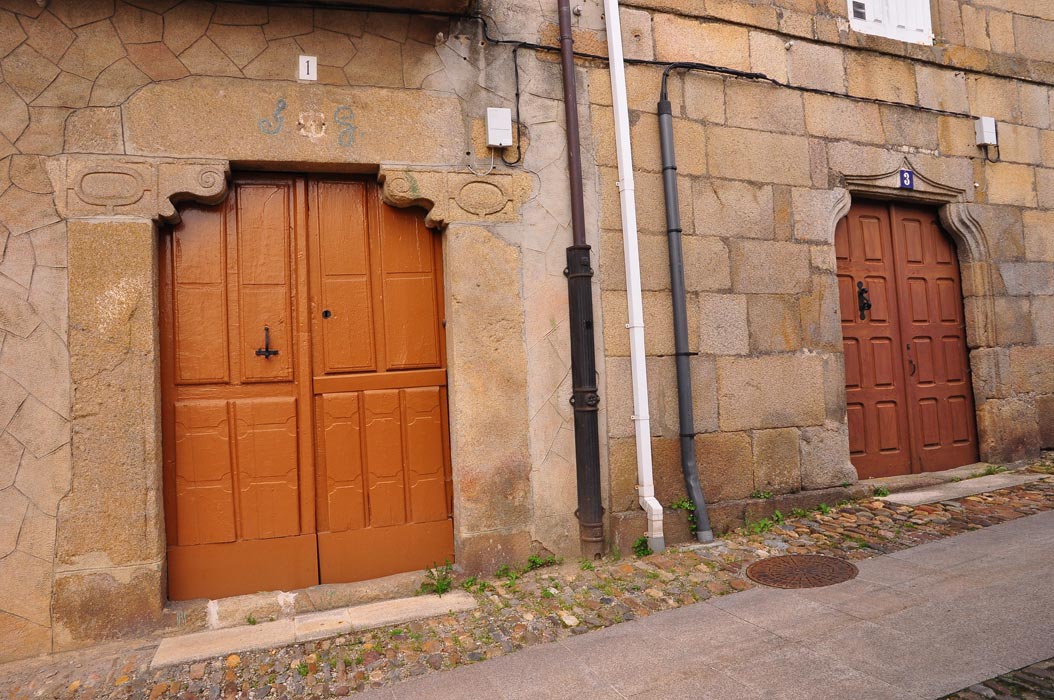
On the last stretch of Falagueira street, the first if according to the numbering, to be precise at numbers 1 and 3, are the houses of the Gaibor, the most relevant of the Jewish and converted families in Monforte whose members were great traders, occupying important posts at the Town Hall or related by marriage later in the 17th century with the Ponce de León and Somoza. These new surnames correspond to the coats-of-arms of the façades, incorporated later onto the properties as the New Christians could not bear their own coat-of-arms except in rare exceptional cases. The Jew Juan de Gaibor, the secretary of the 2nd Count of Lemos, is the first member of this family with sound Jewish roots summonsed by the Inquisition, then followed by their son, Jorge de Gaibor, christened at an advanced age.
The convert problem
Cohabitation between Christians and Jews had already suffered since the mid-14th century and the hostility of the Old Christians to the converts had led to violent persecutions, some on the eve of Isabel´s coming to the Castilian throne.
The problem of the converted Jews was both social and religious. The chance the New Christians had of accessing positions of command in the urban oligarchies´ led to the suspicion amongst the masses of the cities. Furthermore, the idea was widespread that the converts were still largely faithful to the Jewish tradition: Any unpleasant actions occurring at the time (including ritual murders) could be laid at the door of the Judaizers in the popular mind.
Against this backdrop, the Catholic Monarchs thought about the possibility of arbitrating a procedure for pursuing false converts. This procedure was called the Inquisition, a court which had already existed in Europe in the Middle Ages. Maybe some converts were involved in the decision, violently hostile to their former fellow worshippers like Tomás de Torquemada, the first grand inquisitor of Castile. What´s for sure is that the Catholic Monarchs ended the traditional tolerance practised in the Hispanic kingdoms until their reign.
La Xuderia (the Jewish quarter)
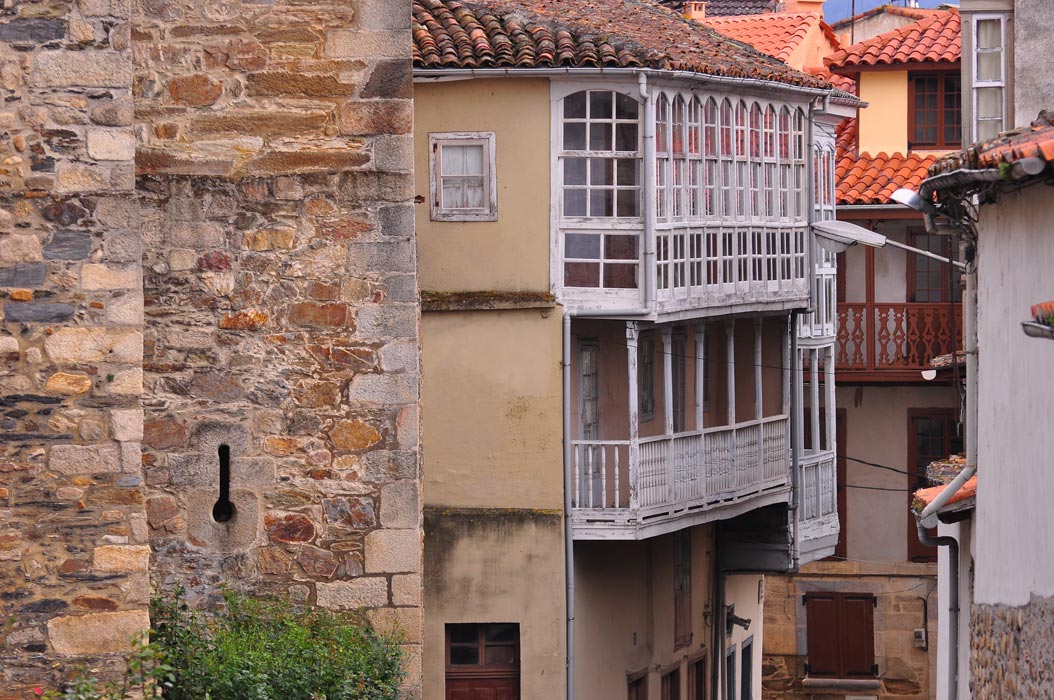
Monforte was one of the Galician settlements with the largest Jewish populations. As elsewhere, the Jews of Monforte were not obliged to live in a certain district and their presence extended throughout the city. Despite this, they had their communal building situated in the area of Falagueira street, A Rúa Vella (old street), A Zapatería (Cobblers´ street) (today known as Travesía de la Cárcel Vieja – Old Prison crossing), AçougueSquare (Pescadería Square) or Rúa de los Herreros (Blacksmith street – now part of España square), were inhabited by Jewish families until the expulsion of 1492.
Palace of the Counts of Lemos
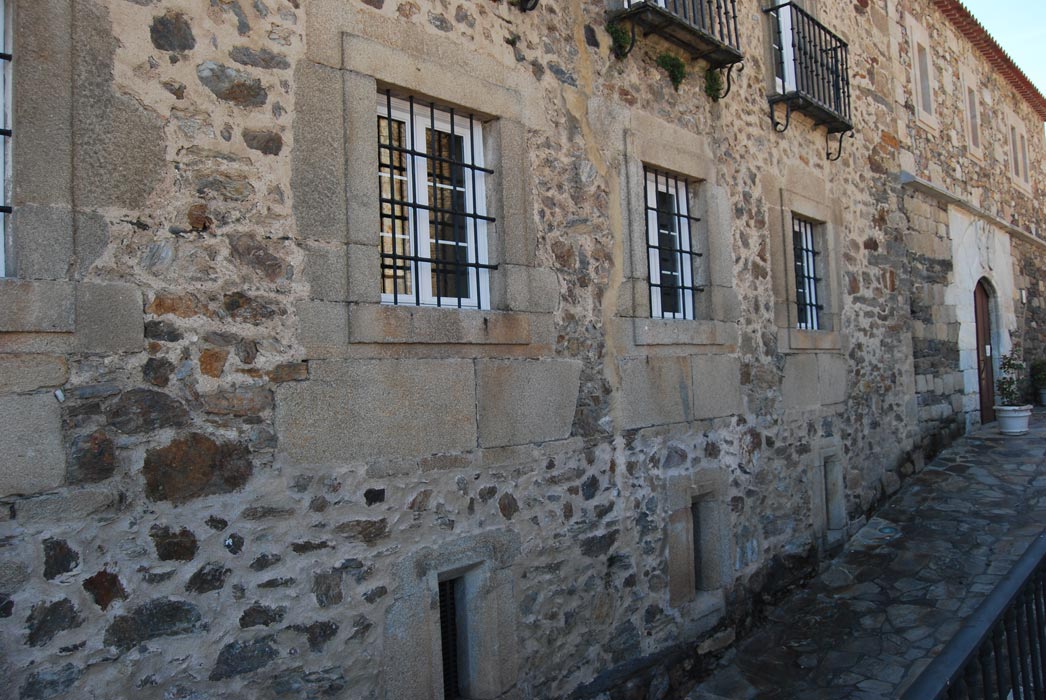
The Counts of Lemos were one of the most important noble families in Spain. Particularly relevant was the figure of the 7th Count, Don Pedro Fernández de Castro, who eventually became the Vice-rey of Naples and who is recalled as a patron of Cervantes, Lope de Vega, Quevedo and Góngora.
Alongside the Homage Tower, the Count´s Palace of the lords (later the hereditary, perpetual counts) of Lemos, integrated with the monastery of St. Vincent into the Tourist hotel facilities, sets the tone for a town traditionally subject to top-down governance.
To replace the former medieval palace, the 3rd countess of Lemos, doña Beatriz de Castro, erected a new construction in the 16th century which suffered a devastating fire in the late 18th century. The old count´s palace is still protected by the remains of the Monforte fortified complex and its façade, supported by Angels, maintains the magnificent family coat-of-arms.
Ponte Vella (Old Bridge)
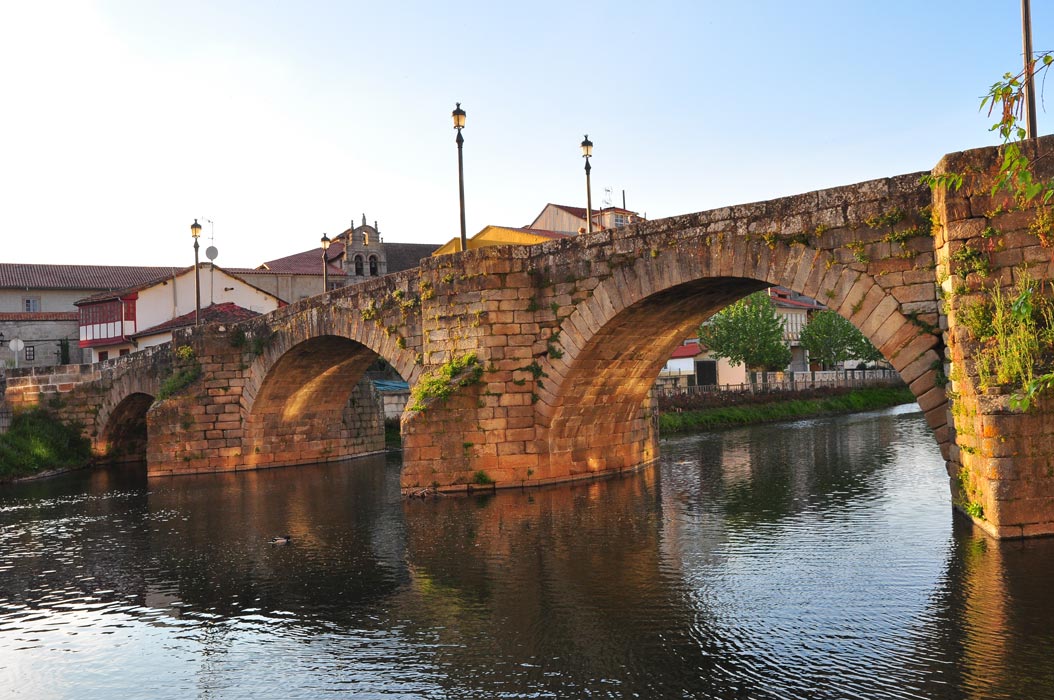
From España square, Comercio Street; crossing Doutor Casares square as far Ponte Vella, passing over the river Cabe which according to tradition has a Roman origin, though its current construction dates from the 16th century, the work of master Pedro Rodríguez de Remberde. From the bridge the final stretch of Abelardo Baanante Street can be seen and, in particular, the structure of the old city, solidly erected on the Mount of Saint Vincent with the Homage Tower dominating the panorama.
Porta Nova (New Gate)
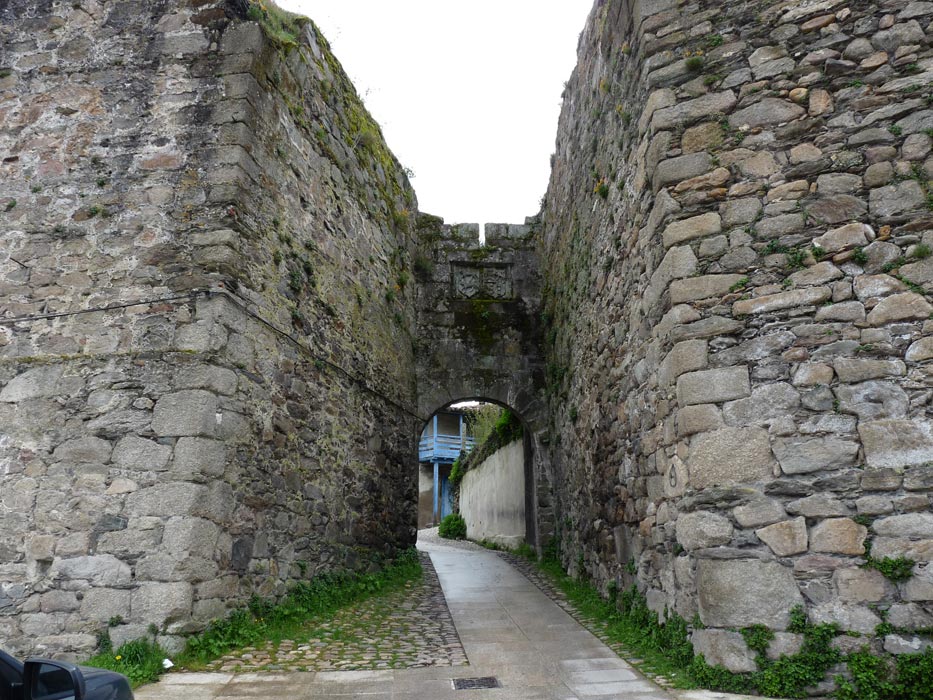
Following the road which spirals down from the top of the mountain, a small diversion leads us to the puerta Nova (New gate), the most monumental of the two conserved in the former medieval layout. The gate, rebuilt between 1470 and 1486 by the 1st Count of Lemos on a previous one and destroyed by the Irmandiños in 1467, conserves its signs of a medieval headstone and is again dominated by the coat-of-arms of the hereditary and perpetual counts. Inside the walls, in the shelter of this gate which saled the town to the east, there was a nucleus of Jewish houses whose heirs today are some colourful buildings which conserve the rows of wooden balconies and corridors of the area.
Glossary
- :
- jewish quarter: Traditional name given to the Jewish district or part of a city where the Jews´ homes were concentrated. In some cases it was determined by law as an exclusive place of residence of the members of this community. By extension, the term applies to any area known to be inhabited by families of Jewish culture.
- mikveh, l. heb: Ritual bathing. Space where the purification baths prescribed by Judaism are taken.
- pentateuch: The first five books of the Bible which form the Torah or Jewish law by antonomasia.
- torah, l. heb: Text of the first five books of the Bible.
- aljama, l. heb: Specific institution of the Medieval Hispanic kingdoms which dealt with the governance and internal administration of the Jewish community.
- converts converts: A christened Jew who has converted to Christianity.Jews converted to Christianity who returned to their place of origin after expulsion.
- synagogue, l. gr: Gathering place for faithful Jews and the place of worship and studies. The term comes from the Greek synagogē which means place of congregation.

